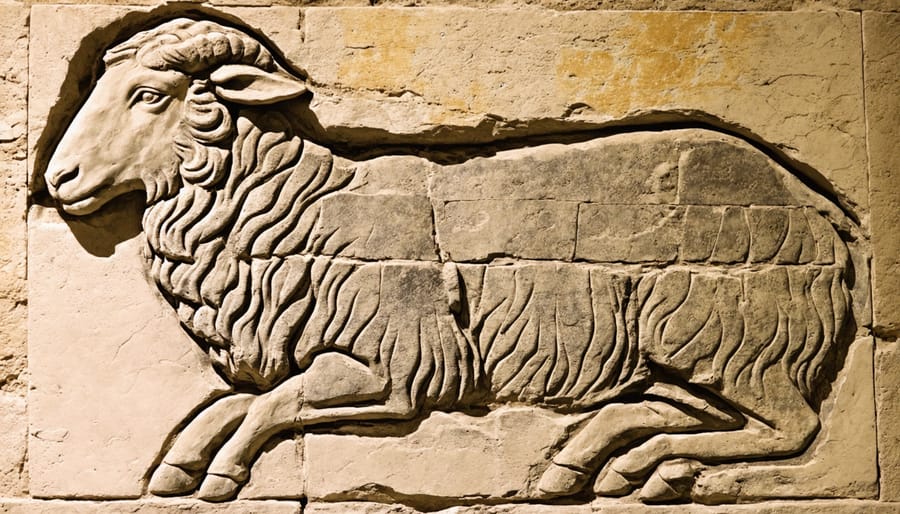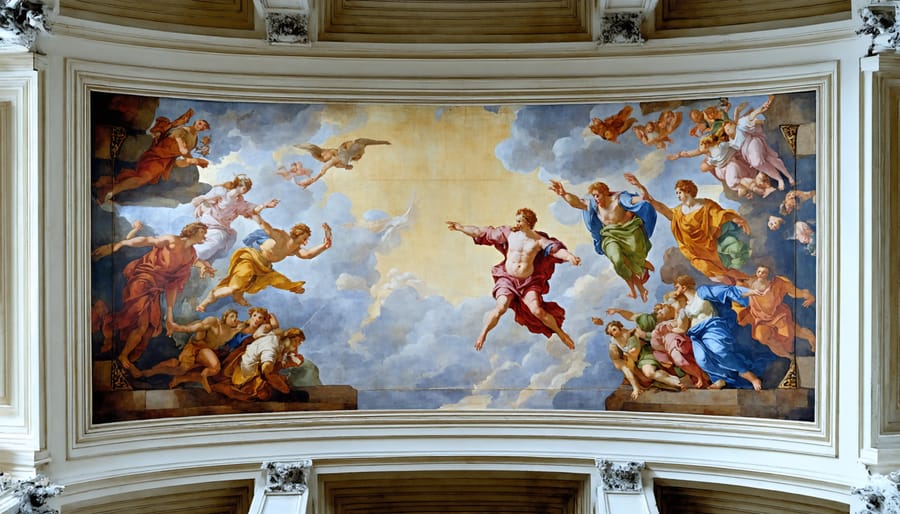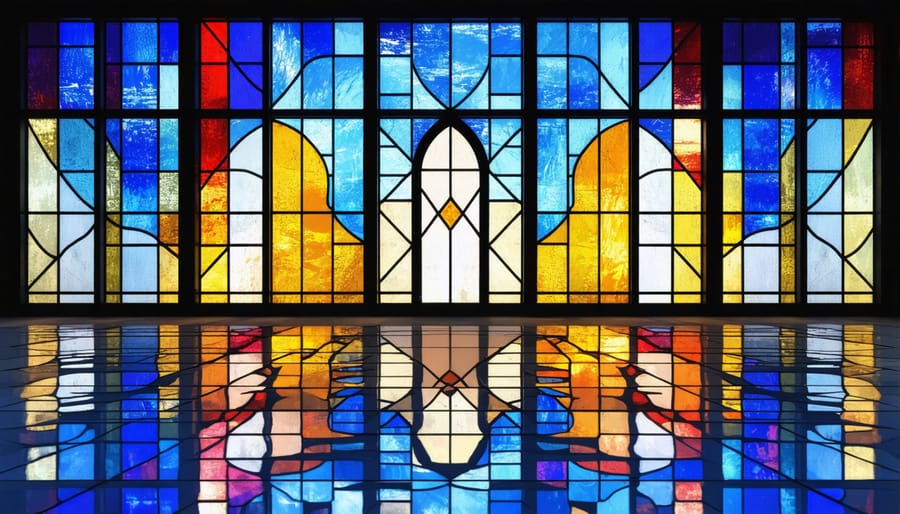Christianity’s profound influence on human culture stands as one of history’s most transformative forces, shaping everything from our artistic expressions to our fundamental values. From the soaring spires of Gothic cathedrals to the timeless melodies of Bach’s compositions, Christian faith has woven itself deeply into the fabric of human creativity and expression across centuries.
For over two millennia, Christian beliefs and practices have inspired countless artists, musicians, writers, and thinkers to create works that explore the depths of human spirituality and our relationship with God. This artistic legacy continues to resonate today, influencing modern cultural expressions and providing a rich foundation for contemporary creators who seek to express their faith through various mediums.
“Whatever you do, work at it with all your heart, as working for the Lord” (Colossians 3:23) embodies the spirit with which Christians have approached cultural creation throughout history. This divine inspiration has given rise to masterpieces that transcend mere artistic achievement to become powerful testimonies of faith, hope, and love.
As we explore Christianity’s cultural influence, we discover not just a historical phenomenon, but a living, breathing force that continues to shape our world through architecture, literature, music, visual arts, and countless other expressions of human creativity dedicated to glorifying God.
The Living Canvas of Faith: Christian Art Through the Ages
From Catacombs to Cathedrals
The journey of Christian art and architecture reflects the remarkable transformation of the early Church from a persecuted minority to a flourishing spiritual force. In the dimly lit catacombs of Rome, our earliest brothers and sisters in faith created simple yet meaningful artwork that spoke of hope and salvation. These underground galleries housed some of the first profound symbols in Christian art, such as the fish, dove, and Good Shepherd, which conveyed deep spiritual truths during times of persecution.
As Christianity emerged from the shadows, believers began expressing their faith through increasingly elaborate architectural wonders. The conversion of Emperor Constantine marked a pivotal moment, leading to the construction of magnificent basilicas that would set the template for Christian worship spaces. These early churches incorporated elements from Roman architecture while developing distinctly Christian features like the cross-shaped floor plan and east-facing altar.
The evolution from humble house churches to soaring Gothic cathedrals mirrors the spiritual journey of faith itself – from quiet, personal devotion to grand, communal worship. These sacred spaces were designed not merely as buildings, but as prayers in stone that drew the faithful’s eyes and hearts heavenward. Through carefully planned architecture and meaningful artwork, each structure became a three-dimensional Bible, teaching Scripture through visual elements that could be understood by all believers, regardless of their ability to read.

Renaissance Revelations
The Renaissance period marked a glorious revival of Christian artistry, where faith and creativity merged to produce some of the world’s most cherished masterpieces. During this golden age, artists like Michelangelo, Leonardo da Vinci, and Raphael created works that continue to inspire millions of believers and art enthusiasts alike. The Sistine Chapel ceiling, perhaps the most famous example, demonstrates how artistic expression can elevate our spiritual understanding and draw us closer to God’s glory.
This remarkable period saw artists portraying biblical narratives with unprecedented realism and emotional depth. Through their masterful use of perspective, light, and human form, Renaissance artists made sacred stories more accessible and relatable to ordinary believers. The Last Supper by Leonardo da Vinci, for instance, captures the profound human drama of Jesus’s final meal with His disciples, helping viewers connect more deeply with this pivotal moment in Christian history.
The influence of Renaissance Christian art extends far beyond its time, shaping how we visualize biblical stories today. These works continue to serve as powerful tools for teaching Scripture, inspiring worship, and sharing the Gospel. Modern churches still draw upon Renaissance techniques and symbolism in their architectural designs and decorative elements, creating spaces that direct our hearts and minds toward heaven. This artistic legacy reminds us that beauty can be a pathway to experiencing God’s presence and understanding His truth more fully.

Beyond the Church Walls
Modern Art’s Sacred Roots
While Christian art historically transformed Western culture, its influence continues to shape contemporary artistic expression in profound ways. Today’s artists draw upon centuries of Christian symbolism to explore themes of faith, redemption, and spiritual transformation in fresh, innovative forms.
Modern artists like Makoto Fujimura blend traditional Christian imagery with abstract expressionism, creating works that speak to both ancient truth and contemporary experience. His “Four Holy Gospels” project exemplifies how sacred themes can be reimagined through modern artistic languages while maintaining deep spiritual significance.
In street art, we see Christ-inspired imagery appearing in urban settings, making spiritual messages accessible to new audiences. Artists like Charlie Mackesy use simple yet powerful illustrations to convey biblical messages of hope and love in ways that resonate with today’s viewers.
Digital artists are also finding new ways to express Christian themes through technology. Virtual reality installations of biblical scenes and digital representations of religious experiences are bringing sacred stories to life for younger generations.
Even in secular galleries, Christian symbolism persists. The cross, the dove, and imagery of light versus darkness continue to appear in contemporary works, often sparking meaningful discussions about faith and spirituality in modern society.
This ongoing influence reminds us that Christian art isn’t merely historical – it’s a living tradition that continues to evolve and speak to each new generation. As artists reinterpret sacred themes through contemporary mediums, they create bridges between ancient faith and modern expression, ensuring that Christian visual language remains relevant and impactful in today’s world.
Popular Culture’s Biblical Inspiration
Christianity’s influence on popular culture remains profound, with biblical themes and narratives continually inspiring countless works across various media. From Hollywood blockbusters to chart-topping music, these sacred stories continue to resonate with modern audiences in meaningful ways.
In cinema, films like “The Prince of Egypt” and “Ben-Hur” have brought biblical narratives to life for new generations, while movies such as “The Matrix” and “The Lion, the King, and the Wardrobe” incorporate Christian allegories and themes of sacrifice, redemption, and resurrection. Even superhero films often draw parallels to biblical characters, with Superman and other heroes embodying Christ-like qualities of self-sacrifice and salvation.
The music industry has been equally influenced by Christian themes. From traditional gospel to contemporary Christian music, artists continue to express their faith through song. Even mainstream musicians frequently incorporate biblical references and spiritual themes in their work. Artists like U2, Johnny Cash, and Chance the Rapper have openly integrated their faith into their music, reaching diverse audiences with messages of hope and redemption.
Literature has perhaps been most profoundly shaped by Christian influence. C.S. Lewis’s “Chronicles of Narnia” series and J.R.R. Tolkien’s “The Lord of the Rings” showcase how biblical themes can be woven into fantasy narratives. Contemporary authors continue this tradition, creating works that explore faith, morality, and spiritual journey in ways that resonate with modern readers.
These creative expressions serve as bridges between faith and culture, making biblical messages accessible to broader audiences while preserving their spiritual significance. They demonstrate how Christianity’s timeless themes continue to inspire and shape our cultural landscape.
Living Faith Through Art Today

Art as Ministry
Modern churches are increasingly embracing creative arts ministry as a powerful tool for spreading the Gospel and enriching worship experiences. Through various artistic mediums such as painting, dance, drama, and music, congregations are finding innovative ways to connect with both believers and seekers alike.
Visual arts have become particularly significant in contemporary worship spaces, with churches commissioning murals, installations, and multimedia presentations that bring Biblical narratives to life. These artistic expressions serve multiple purposes: they create welcoming environments, facilitate spiritual reflection, and provide opportunities for community engagement.
Many congregations now incorporate live painting during worship services, where artists create pieces inspired by the sermon or worship music. Others host art galleries featuring faith-inspired works from local artists, creating bridges between the church and the broader community. Dance ministries and drama teams present Biblical stories in dynamic ways that resonate with modern audiences, especially youth and children.
This artistic approach to ministry reflects the understanding that God, the ultimate Creator, has gifted His people with creative abilities to glorify Him and draw others closer to faith. As Exodus 35:35 reminds us, “He has filled them with skill to do all kinds of work as engravers, designers, embroiderers… all of them skilled workers and designers.”
Through these artistic expressions, churches are breaking down barriers and creating meaningful connections that transcend cultural and generational differences.
Creative Expression in Christian Communities
In today’s Christian communities, artists are finding innovative ways to express their faith through various creative mediums. From contemporary worship music that blends traditional hymns with modern sounds to visual artists who incorporate biblical themes into their work, these expressions of faith continue to shape and reflect Christian culture.
Many Christian artists are embracing digital platforms to share their faith-inspired creations. Social media has become a canvas for sharing biblical art, devotional photography, and inspiring designs that speak to both believers and non-believers alike. These modern artists often combine traditional Christian symbolism with contemporary artistic styles, making sacred themes more accessible to younger generations.
Visual storytelling through film and animation has emerged as a powerful medium for sharing biblical narratives and Christian values. Independent Christian filmmakers are producing content that explores faith journeys, while graphic designers create meaningful worship visuals that enhance church services and online ministry.
In the performing arts, Christian theater groups and dance ministries are reimagining biblical stories and spiritual themes for contemporary audiences. Sculptors, painters, and installation artists are creating works that invite contemplation of divine truth and inspire spiritual reflection in both sacred and secular spaces.
This creative renaissance within Christian communities demonstrates how faith continues to inspire artistic expression, fostering deeper connections between spirituality and culture while making the Gospel message relevant and engaging for modern audiences.
Biblical Perspectives on Art and Creativity
The creative spirit woven throughout Scripture reveals God as the ultimate artist, beginning with His masterful work of creation. This divine creativity sets the biblical foundations for creativity that continue to inspire believers today. In Genesis 1:27, we learn that humanity is made in God’s image, suggesting that our creative abilities reflect His divine nature.
Throughout the Old Testament, we see God’s detailed instructions for artistic expression in the construction of the Tabernacle and Temple. He specifically appointed craftsmen like Bezalel, filling him with “the Spirit of God, with wisdom, with understanding, with knowledge and with all kinds of skills” (Exodus 31:3). This divine endorsement of artistic skill demonstrates that creativity serves a sacred purpose in worship and community.
The Psalms showcase the beauty of poetic expression in worship, while the Song of Solomon celebrates the artistry of romantic literature. These biblical examples affirm that artistic expression can glorify God while exploring the full range of human experience and emotion.
In the New Testament, Jesus himself used creative storytelling through parables to convey spiritual truths, showing how art can bridge the gap between divine wisdom and human understanding. His approach teaches us that creativity can be a powerful tool for sharing God’s message and building community.
The Bible encourages believers to use their gifts to honor God and serve others (1 Peter 4:10). This includes artistic talents, which can be used to beautify sacred spaces, enhance worship experiences, and communicate biblical truths in fresh and meaningful ways. Whether through music, visual arts, dance, or other creative expressions, Christians are called to reflect God’s beauty and truth through their artistic endeavors.
This biblical perspective on creativity continues to inspire countless artists, musicians, and creators within the Christian community, fostering a rich tradition of faith-inspired art that speaks to both believers and non-believers alike.
Throughout history, the relationship between Christianity and art has been a profound testament to how faith can inspire creativity and beauty. As we’ve explored, this legacy continues to enrich our lives today, inviting us to participate in a tradition that spans centuries of human expression and devotion.
Whether through the soaring spires of Gothic cathedrals, the tender brushstrokes of Renaissance Madonnas, or contemporary Christian music and visual arts, these creative expressions help us connect with our faith in deeply personal ways. They remind us that God, the ultimate Creator, has blessed us with the ability to create and appreciate beauty in His name.
As believers in the modern world, we have the unique opportunity to both preserve and contribute to this rich artistic heritage. Whether we’re admiring historical masterpieces, supporting contemporary Christian artists, or creating our own expressions of faith, we participate in a living tradition that continues to evolve and inspire.
Let us remember that art in the Christian tradition isn’t merely about aesthetics—it’s about sharing the Gospel, expressing our worship, and drawing closer to God. As we move forward, may we continue to engage with and celebrate the artistic expressions of our faith, recognizing them as powerful tools for ministry, worship, and spiritual growth.
In doing so, we honor both our cultural heritage and our calling to share God’s love through every available means, including the transformative power of art.
